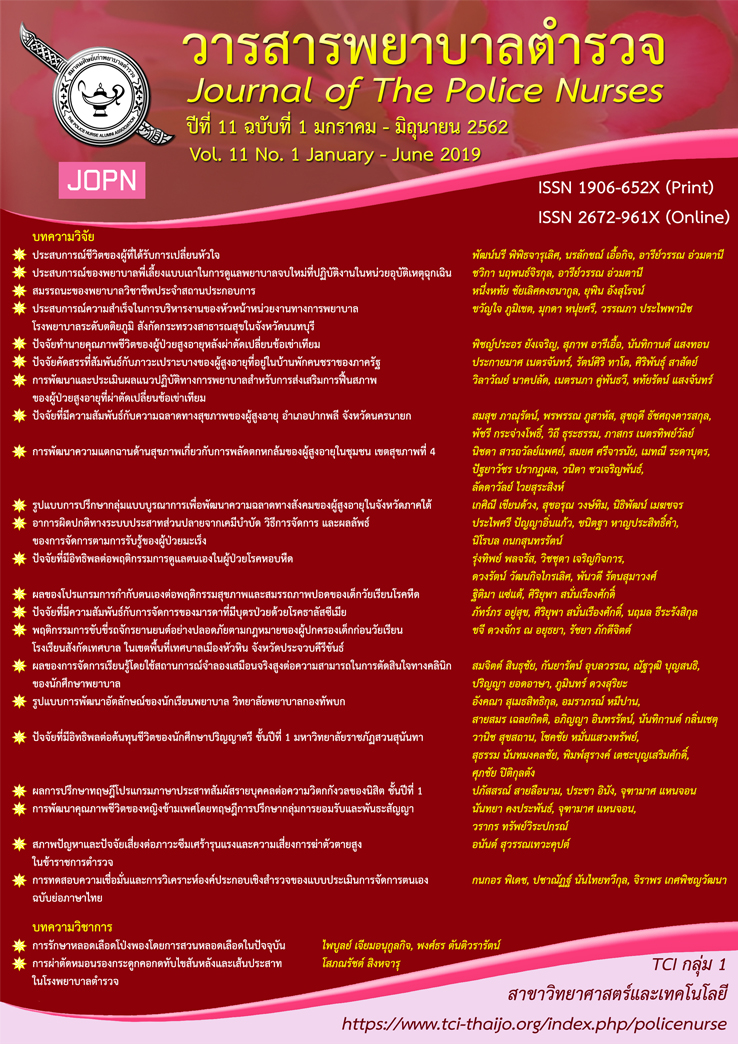RELIABILITY AND EXPLORATORY FACTOR ANALYSIS OF THAI VERSION FOR THE PATIENT ACTIVATION MEASURE SHORT FROM QUESTIONNAIRE
Keywords:
reliability, exploratory factor analysis, a short form of The Patient Activation Measure (PAM)Abstract
This research was a descriptive study. The aim of study was to investigating the reliability and exploratory factor analysis of a Thai version short form of The Patient Activation Measure (PAM). The evidence base was used in the context that was suitable for Thai people relying on the standardized translation process. Translations were done from original to Thai version. And then the content validity was checked by 5 experts. The reliability of the translated Thai version was examined by distributing questionnaire to 300 patients with orthopaedics disease. The statistical analysis was used for the reliability and exploratory factor analysis.
The result of this study found a Thai version short form of PAM could be translated into Thai without major difficulties. The overall Cronbach’s alpha coefficient of the PAM Thai version was .74 and item-total correlations were .71 - .83. Thai version of PAM achieved a good level of reliability. The results of the exploration factor analysis by using Kaiser-Myer-Olkin’s measures of sampling adequacy (KMO) was .85. Bartlett's test of sphericity statistics showed that the chi-Square (χ2) statistic was 916.10, which had a statistically significant level at .05. The elements could be extracted in 4 components. The value of eigen is between 1.06-4.23 and the cumulative variance was 58.18%. Finally, the research demonstrated that the translated of PAM Thai version is suitable for use in Thai patients with orthopaedics disease.
Downloads
References
Brislin, R. W., Lonner, W. J., & Berry, J. W. (1986). Field methods in cross-cultural research. Beverly Hills: SAGE.
Creer, T. L., & Holroyd, K. A. (2006). Self-management of chronic conditions: the legacy of Sir William Osler. Chronic Illness, 2(1), 7-14.
Greene, J., Hibbard, J. H., & Tusler, M. (2005). How much do health literacy and patient activation contribute to older adults' ability to manage their health? AARP Public Policy Institute Washington, DC.
Hibbard, J. H., Mahoney, E. R., Stock, R., & Tusler, M. (2007). Do increases in patient activation result in improved self-management behaviors? Health services research, 42(4), 1443-1463.
Hibbard, J. H., Mahoney, E. R., Stockard, J., & Tusler, M. (2005). Development and testing of a short form of the patient activation measure. Health services research, 40(6), 1918-1930.
Hibbard, J. H., Stockard, J., Mahoney, E. R., & Tusler, M. (2004). Development of the patient activation measure (PAM): Conceptualizing and measuring activation in patients and consumers. Health services research, 39(4), 1005-1026.
Kaemkate, W. (2014). Handout of exploratory factor analysis.
Mukoro, F. (2012). Summary of the evidence on performance of the patient activation measure (PAM). NHS Kidney Care, 1-22.
Nantaga, S. (2011). Instrument translation for cross-cultural research: Technique and Issues to be considered. Thai journal of Nursing Council, 26(1), 19-28.
Nongyoaw, P. (2007). Effects of a telephone education program on self-care behavior for rehabilitative fractured femur patients. Songklanagarind Medical Journal, 25(1), 19-27.
Ritklar, R. (2012). Effects of a self-management program on self-managment behaviors, dyspnea, activities of daily living, and quality of life among patients with congestive heart failure. Nursing Jornal, 3(1), 65-76.
Skolasky, R. L., Mackenzie, E. J., Riley, L. H., & Wegener, S. T. (2009). Psychometric properties of the patient activation measure among individuals presenting for elective lumbar spine surgery. Quality of Life Research, 18(10), 1357-1366.
Skolasky, R. L., Mackenzie, E. J., Wegener, S. T., & Riley, L. H. (2008). Patient activation and adherence to physical therapy in persons undergoing spine surgery. spine, 33(21), E784-E791.
Supamas, A. (2008). Statistical analysis for social science and behavioral research: Techniques for using the program lisrel. Bangkok: Mission Media.
The National Statistical Office. (2010). Survey on health and welfare.
Wiwat, T. (2009). The content improvements of the Thai version of the minnesota living with heart failure questionnaire using cognitive interview. Thai Pharmaceutical and Health Science Journal, 4(2), 227-235.
Wirojcharoenwong, W. (2015). A explorator factor analysis of computer self-efficacy. RMUTP Research Journal Special Issue The 5th Rajamangala University of Technology National Conference.
Downloads
Published
How to Cite
Issue
Section
License
ผลงานที่ได้ตีพิมพ์แล้วจะเป็นลิขสิทธิ์ของวารสารพยาบาลตำรวจ















